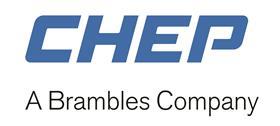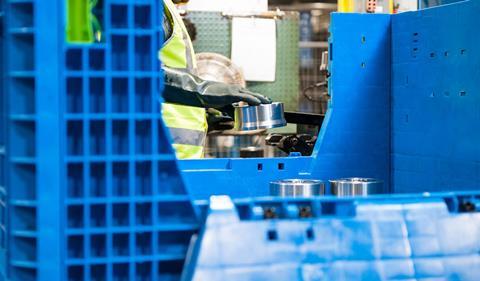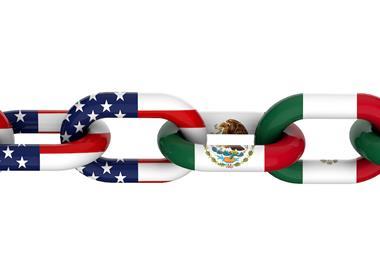This content was produced by Automotive Logistics in partnership with CHEP
Trade regulations, combined with the need for supply chain resilience and cost savings, are driving nearshoring in North America. CHEP’s director of automotive, Patrick Mahoney, shares with Automotive Logistics how the company’s share-and-reuse packaging services support this trend.

In terms of automotive parts, Mexico is now both the world’s fourth-largest producer and the largest export market for the US. As a leading global supply chain partner, is CHEP witnessing a nearshoring trend on the North American continent?
Absolutely, and it isn’t limited to the automotive industry. At CHEP, we advance the smart and sustainable movement of goods, ranging from consumables to industrial components across a number of key verticals. Across the board, supply chain reorganisation is bringing suppliers closer to clients in the US, Canada and Mexico.

What would you cite as the main drivers of North American nearshoring?
A first wave of supplier nearshoring to Mexico occurred during a period of significant trade agreement updates in 2020 in North America. This was cost- led. Take the automotive industry as an example: the inclusion of rules of origin for automotive parts now requires a minimum percentage of a vehicle’s components to be produced in North America to qualify for tariff-free treatment. OEMs therefore saw an immediate opportunity to remain competitive by nearshoring their supply network to Mexico. Additionally, the pandemic prompted a second wave of nearshoring as companies sought to enhance supply chain resilience.
And what will happen moving forward in the North American automotive supply chain?
Cost and operational efficiency are key drivers in any supply chain, so the continuation of the current nearshoring trend is certainly possible. The only thing capable of slowing it down would be a dip in demand for new vehicles.
Judging by the ongoing construction of manufacturing and warehousing facilities in Mexico, preparations are underway to meet increased demand. There have been substantial investments in infrastructure and connectivity improvements in Mexico, along with the introduction of various incentives to attract foreign investment. At CHEP, we help customers access support through Mexico’s IMMEX (Manufacturing, Maquiladora and Export Services) programme, effectively alleviating import and export taxes for temporary imports during an 18-month maximum period.
How is nearshoring reshaping supply chain logistics in the automotive sector?
As mentioned, nearshoring represents, in part, a desire for more resiliency and companies are reaping those benefits. What does that look like in practice? It means overall costs are higher across the board, with notably the United States-Mexico- Canada Agreement (USMCA) encouraging a progressive rise in Mexican wages. The flip side is that if things go wrong, it’s ultimately more affordable. In short, companies operate at marginally higher running costs but bet on affordability over the long term. Equally, there are supplementary advantages to suppliers being in the same time zone as their OEM clients, notably for lead times and communication. That can only impact positively in terms of quality assurance.
Can nearshoring also present challenges?
Supply chains are never without challenges. At CHEP, we offer transport and packaging services, but our in-market teams also navigate the administrative red tape that accompanies moving goods from any one country to another. Crossing an international border can incur problems or delays.
The difference between offshoring and nearshoring lies in the duration of those disruptions: what can be a delay of a week when importing from Mexico into the US or Canada could be a month when shipping intercontinentally.
In CHEP’s experience of transporting automotive parts, what challenges are particular to North America?
Offshoring to continents like Asia allows North American automotive OEMs to access inexpensive expendable (single- use) packaging but the real challenge lies in the high cost of intercontinental shipping.

To combat this, the focus for packaging is not on lineside presentation, but rather on optimising shipping container space by offering better packaging density an stacking. Conversely, nearshoring to Mexico allows companies to benefit from more affordable transport and improved lineside presentation. However, these are still long lanes with a border crossing making reusable packaging seem complicated due to its impracticality and the cost of return runs. Despite the waste and rising costs, companies looking for ease of doing business within North America sometimes still favour therefore expendable packaging.
How can working with a reusable packaging partner like CHEP help?
Container rental services are often seen as moving capital expenditure (Capex) to operational expenditure (Opex) by outsourcing a packaging strategy that could be managed internally. What we offer at CHEP is different. We offer OEMs something they can’t find in-house: geographical proximity to the entirety of their supply network. We do this via a share and reuse pool of hundreds of thousands of containers, managed through an extensive network of 15 service centres across the US, Canada and Mexico. By reducing empty returns, CHEP redefines reusable packaging to offer both a cost and just-in-time advantage for the automotive supply chain. CHEP offers the convenience of cardboard with the benefits in quality and truckload utilisation of returnable packaging. This is gaining importance on a continent where expendable packaging has become more costly.
What future technology trends do you foresee for reusable packaging services in nearshored automotive supply chains?
Smart containers – equipped with tracking and connectivity features – aren’t new to the automotive supply chain, but better supply chain management will come from their optimisation. At CHEP we continuously invest in connected technology, as we believe it is key to further advancing the smart and sustainable movement of goods worldwide. Smart containers offer more reliable shipments, consistently ensuring clients get the right product to the right location at the right time. Moving forward, technology improvements will allow for even better connectivity, transparency and protection, whether suppliers are offshored or nearshored. CHEP’s operating model provides inventory and cycle time data at all locations throughout the supply chain.
What will the North American automotive supply chain look like ten years from now? And how will reusable packaging services have evolved?
Many industries, from healthcare to finance to energy, state their future lies in data. The North American supply chain is no different. Reusable packaging offers the opportunity to monitor individual shipments, but its real potential is in aggregate data harvesting from a larger pool. Knowing where all containers are located, what they contain, and where they are heading at any one time is essential for any company looking to optimise its supply chain operations. At CHEP, we don’t just have the capacity to aggregate data from one client but from all of our clients. This allows us to manage fluctuations in packaging demand across diverse verticals. If nearshoring continues to grow as predicted in North America, it will drive increased demand for packaging. Reusable packaging services that optimise their data will be in a position to anticipate and meet that demand.


























![Global[1]](https://d3n5uof8vony13.cloudfront.net/Pictures/web/a/d/s/global1_726550.svgz)













No comments yet